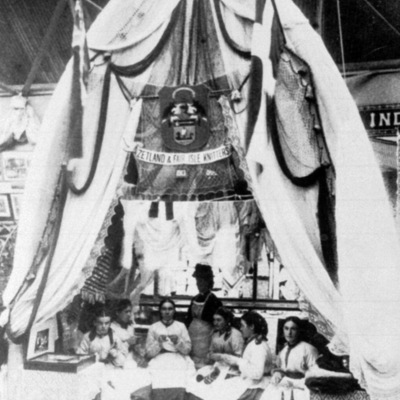The 'Jaw Bone' Stand at the Edinburgh International Exhibition, 1886
Title
Category
Description
This photograph shows the eye-catching Shetland Stand from the Women’s Industries section at the Edinburgh International Exhibition of Industry, Science and Art in 1886. It represents a group of women knitters as a community of craft workers, though three of the girls were from Mainland Shetland and three from nearby Fair Isle. The standing figure is Barbara Muir, sister of Margaret Currie who ran Currie & Co a truck-free shop buying and selling Shetland knitting from premises at Freefield Docks in Lerwick. The women attended the exhibition to raise awareness of the skills of Shetland’s knitters and to sell hand-knitted goods made on the islands.
The unusual shape of the stand reflects its construction from whale jawbones, prize remnants from another important Shetland industry. Shetland flags are displayed on either side of the Shetland coat of arms with its distinctive longboat motif and a horizontal banner reads ‘Zetland and Fair Isle Knitters’. The display includes a spinning wheel, a woven kishie (basket) perhaps to hold skeins of wool, and tables on each side of the stand that are draped with fine lace knitted squares. A large lace shawl is one of the many items pinned and draped above the knitter’s heads in this photograph.
Fishing and crofting were key industries on Fair Isle and Mainland Shetland but knitting was also economically important to the islands’ communities of women who supplemented their family income and sometimes fed their families on the proceeds of their handiwork. Girls were taught to knit as soon as they were old enough to hold needles, creating items of clothing - shawls, vests and socks – that could be sold to visitors or brokered through merchants. Cash payments for knitting were known but knitted items were more frequently exchanged for essential goods and provisions through Shetland’s cashless truck system. This came under scrutiny in 1872 when a Parliamentary Report revealed the economic realities of Shetland knitting. At a time when four-fifths of all the island’s women were thought to be involved in the hosiery industry - whether as spinners, hand-knitters or in subsidiary tasks such as carding wool of garment finishing - claims were made that when paid in goods rather than money the true value of knitting valued at nine shillings was often as low as four shillings (Report to the Board of Agriculture for Scotland, 1914).The Shetland Stand at the Edinburgh Exhibition was organised by G.H. M. Thoms, Sheriff of Orkney and Shetland, Currie & Co and Mr Laurence of Fair Isle as an educational spectacle where visitors could see the processes of the industry – carding, spinning, dyeing and knitting - ‘practically shown’ by the deft fingers of six young women dressed in national costume. (Official Exhibition Catalogue p. 280). The Scotsman newspaper highlighted the display as one especially ‘worthy of notice and proving of great interest to visitors’. It offered an opportunity to bring makers and purchasers together, though prices had to be clearly tagged and items could not be removed by purchasers until the end of exhibition.

